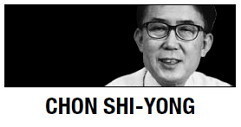
General elections used to produce stars, like the youngest successful candidate, underdogs who defeated big-name politicians or figures who won on enemy turf.
We will have to wait until April 13 to find out who will become the stars of the 20th National Assembly. But in terms of public and media attention, there are already two star players: Kim Jong-in, the stopgap leader of The Minjoo Party of Korea, and Lee Han-koo, the nomination chief of the Saenuri Party.
Since taking over at their respective posts in January and February, Kim and Lee have taken control of key party affairs — namely the nomination of candidates — overcoming the initial internal skepticism and resistance.
With the nomination process in full swing at both parties, they wield such immense power as to defenestrate even senior party figures. No wonder the public and the media, let alone party officials and candidates, follow closely what they say and do. Put simply, the two have taken center stage in the quadrennial election.
Nominations in their hands
Few had imagined that Kim and Lee would gain so much authority and power so easily and in such a short period of time.
Kim was thought to be yet another makeshift chief for the main opposition party, which fell into crisis in the aftermath of the desertion of Ahn Cheol-soo and his followers. But contrary to the prevailing skepticism, he has taken full charge of the party with strong leadership. So much so that now he does not have any qualms about setting new election strategies and even shifting the party’s ideological stance and policy direction away from its usual liberal line.
Likewise, when he was named to head the ruling party’s nomination committee, Lee was not expected to do much more than what his predecessors had done — managing nominations under guidelines set by the party leadership or the Blue House. But he did not hesitate to challenge party leader Kim Moo-sung, and in effect has wrested from him full power to nominate candidates.
Both Kim Jong-in and Lee have been in politics for decades, but they had never been leaders. So what catapulted them into the political limelight so suddenly? Is it a simple coincidence?
It is interesting to note that they have both things in common — some strikingly similar — and, of course, differences. First, both of them have a background in economics: Kim earned his Ph.D. from the University of Munster, while Lee got his from Kansas State University.
But the two have distinctively different views, over which they confronted each other when they were senior members of Park Geun-hye’s ruling party in 2012. Kim advocated “economic democratization,” which calls for, among other things, reining in the concentration of wealth among big conglomerates.
Lee was the leading critic of what he termed a vague concept, arguing that it would only depress the nation’s entrepreneurial spirit. A view fitting of a man who worked for former Daewoo Group chairman Kim Woo-choong for 16 years until 2000.
At that time, Park raised the hand of Kim, installing him as the head of the “Happiness Promotion Committee,” which was entrusted to prepare her pledges for the 2012 presidential election. Kim thus was called as the chief architect of Park’s policy blueprint, which included economic democratization under the motto of bringing happiness to people.
Strikingly similar styles
The two have strikingly similar styles and personalities, and this is seen as the major factor enabling them to take control of the parties, each of which has been plagued by persistent factional strife and are therefore always uproarious.
Most of all, both the men are straightforward, unbending and freewheeling. They have strong self-confidence and self-pride — to the degree to be called self-righteousness and arrogant — so they don’t have any qualms about asserting their opinions.
For instance, the first thing Kim did was demand full authority in nominations and other party affairs. Then he did not hesitate to call for changes, even challenging some taboos in the liberal opposition party, like expressing skepticism about former party leader President Kim Dae-jung’s engagement policy toward North Korea, and criticizing labor unions’ “excessive involvement in social issues” rather than workers’ rights.
These moves – which are not typical of a leader of the left-wing opposition party — may be part of Kim’s strategy to broaden the support base for his party ahead of the election by shifting it to the right.
At any rate, Kim’s charismatic leadership seems to be working well for now, as seen by his continuing ruthless elimination of veteran party members from the nomination races. His surprise proposal for election unity with Ahn’s People’s Party also enhanced his profile as a key player in the election.
Like Kim, Lee is a man propelled by his own conviction, which he amply demonstrated by confronting party leader Kim Moo-sung over nomination rules and criteria. Lee’s perseverance won over Kim’s endeavors to make the party abide by his “bottom-up nomination rule.” It seems that Lee has now taken full control of candidate selection, brandishing — like the Minjoo Party’s Kim — a machete to indiscriminately ax candidates who his panel sees have low chances of election.
Barring any unexpected developments, both Kim and Lee are likely to continue to dominate nominations. In that case either of them could get the biggest share of the credit — in case of victory — or blame — in case of defeat — when the votes come in on the evening of April 13. At stake will be the future of their parties and their own individual political futures.
By Chon Shi-yong
Chon Shi-yong is the chief editorial writer of The Korea Herald. He can be contacted at sychon@heraldcorp.com. –Ed.

